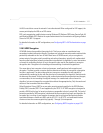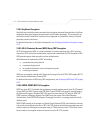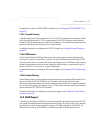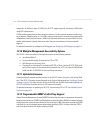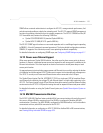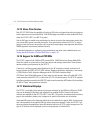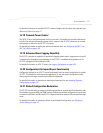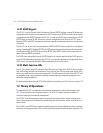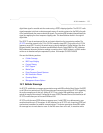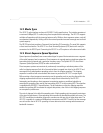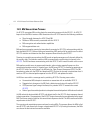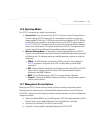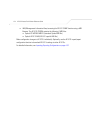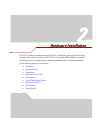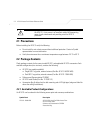
AP-5131 Introduction
1-19
digital data signal is encoded onto the carriers using a DSSS chipping algorithm. The AP-5131 radio
signal propagates into the air as electromagnetic waves. A receiving antenna (on the MU) in the path
of the waves absorbs the waves as electrical signals. The receiving MU interprets (demodulates) the
signal by reapplying the direct sequence chipping code. This demodulation results in the original
digital data.
The AP-5131 uses its environment (the air and certain objects) as the transmission medium.The
AP-5131 can either transmit in the 2.4 to 2.5-GHz frequency range (802.11b/g radio) or the 5.2 GHz
frequency range (802.11a radio), the actual range is country-dependent. Symbol devices, like other
Ethernet devices, have unique, hardware encoded Media Access Control (MAC) or IEEE addresses.
MAC addresses determine the device sending or receiving data. A MAC address is a 48-bit number
written as six hexadecimal bytes separated by colons. For example: 00:A0:F8:24:9A:C8
Also see the following sections:
• Cellular Coverage
• MAC Layer Bridging
• Content Filtering
• DHCP Support
• Media Types
• Direct-Sequence Spread Spectrum
• MU Association Process
• Operating Modes
• Management Access Options
1.3.1 Cellular Coverage
An AP-5131 establishes an average communication range with MUs called a Basic Service Set (BSS)
or cell. When in a particular cell, the MU associates and communicates with the AP-5131 supporting
the radio coverage area of that cell. Adding AP-5131’s to a single LAN establishes more cells to
extend the range of the network. Configuring the same ESSID (Extended Service Set Identifier) on all
AP-5131s makes them part of the same Wireless LAN.
AP-5131s with the same ESSID defines a coverage area. A valid ESSID is an alphanumeric, case-
sensitive identifier up to 32 characters. An MU searches for an AP-5131 with a matching ESSID and
synchronizes (associates) to establish communications. This device association allows MUs within
the coverage area to move about or roam. As the MU roams from cell to cell, it associates with a



